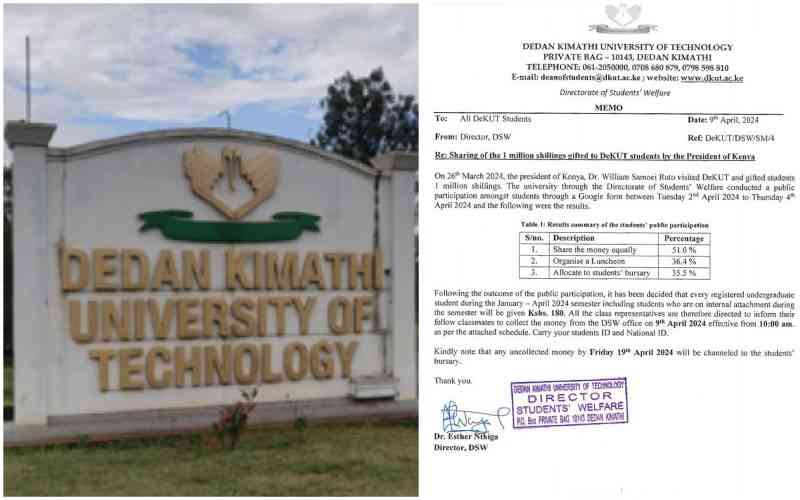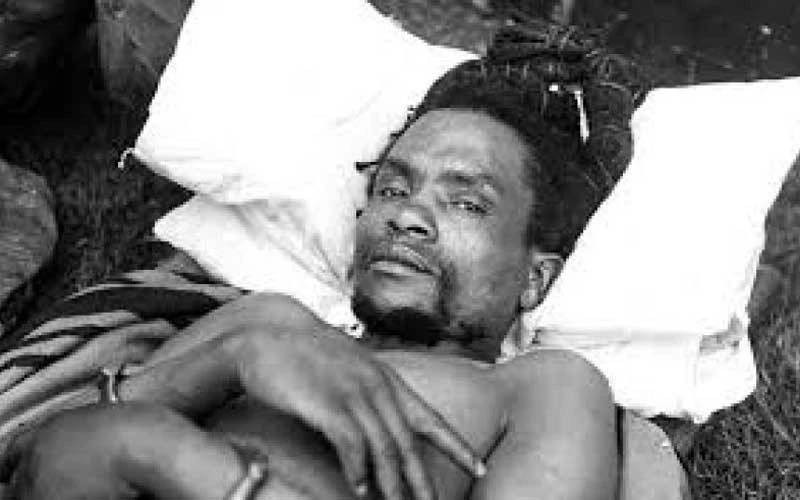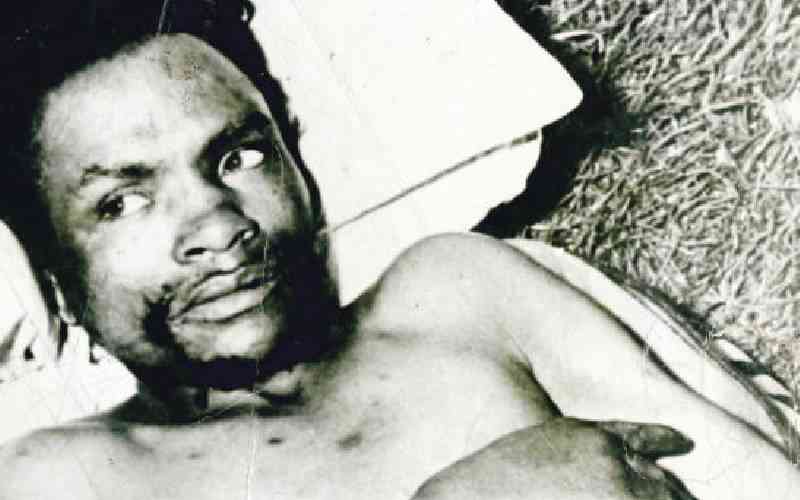 |
|
Meshack Wang’ombe points at the trenches where he found Dedan Kimathi. |
By Lydia Nyawira
NYERI, KENYA: On a barren patch of earth in the midst of green tea bushes on October 21 , 1956, an 18-year-old Meshack Wang’ombe came face to face with his destiny as one of the only Kenyans to carry the late Dedan Kimathi after he was shot.
We meet 75-year-old Wang’ombe in his rural home in Karuniani Village, Tetu Constituency, as he brings his cattle home from grazing.
A cordial Wang’ombe narrates to us how it all happened at around 6am on October 21, 1956.
“I heard gunshots early in the morning and assumed a buffalo had been shot.”
He asked his childhood friend to accompany him and get some buffalo meat. “We grabbed our pangas and headed towards where we heard the gunshots, but once we got there we spotted the administration police,” he recalls.
Wang’ombe and his family were at the time living on the border of the forest where Colonial guards had built deep trenches-fencing off the village from the forest.
Patrol at trenches
According to Antony Maina, the Assistant curator at the Nyeri Museum, the trenches were often patrolled by administration police officers who were lying in wait for Mau Mau fighters who often sneaked into the villages for food and supplies
However, on the fateful day, they had set a trap to capture Kimathi.
“My friend panicked and said we should run back home, but I told him if we did that, they would shoot us. I convinced him to continue walking towards them,” Wang’ombe calmly narrates.
“The Administration police stopped us, asked where we were going and we innocently explained that we thought they had shot down a buffalo and we had come for some meat,” Wang’ombe elaborates as he leans casually on his walking stick.
Wang’ombe says, the guards laughed and pointed at Dedan Kimathi who was on the ground.
“You were looking for meat, here it is,” the officers responded.
Wang’ombe immediately recognised Kimathi who was wearing a unique coat put together from the hides of an antelope and a leopard skin.
Stay informed. Subscribe to our newsletter
“Kimathi was a very clever man, his coat was half-gazelle hide and half-leopard skin to camouflage him regardless of which side he was turning,” Wang’ombe explains.
The guards stood around Kimathi despite the fact that he had a gunshot wounds in the thigh and was in great pain.
Maina quickly points at the spot Kimathi was shot. He points at an area above the deep gully with trenches that had sharp logs erected.
Crawled out
“Kimathi was shot in the thigh and he crawled out of the trench to this spot,” he says.
The spot has a stone monument that reads: “Born 31st October 1920, Died 18th Feb 1957. It is better to die on my feet than to live on my knees afraid of colonial rule. Dedan Kimathi Wachiuri.”
The late Wangari Mathai, former Vice-President Kalonzo Musyoka and former Prime Minister Raila Odinga and many other leaders have planted trees around the spot.
Mr Wang’ombe continues with his tale:
“The guards then asked us to go into the forest and cut down two long branches. We did as we were ordered and when we returned they asked us to go and cut some twine to tie the branches together.”
Wang’ombe and his friend made a makeshift stretcher on which Kimathi was to be carried.
“By the time we put Dedan Kimathi on the stretcher the guards had called two other men who lived nearby to help us carry him to the road,” Wang’ombe says.
The two helped carry Kimathi out of the forest.
Carried him
“He did not speak to us as we carried him, he was in pain, but when we got to the road he said a few words:
“I’m shocked that I have been shot and captured by Africans who I went to the forest to fight for,” these, Wang’ombe says, were his last words.
Wang’ombe’s encounter with the most iconic Mau Mau freedom fighter ended at the dusty road from where Kimathi was transported by car.
Not a hero
He says he does not consider himself a hero for what he did.
“I owe my life to men like Dedan Kimathi, whose struggle liberated all of us. I can own cows and a piece of land because of what he and brave men like the late President Jomo Kenyatta did for this country,” he says.
Maina says the community that lives around the spot where Dedan Kimathi was captured have requested the Government to gazette 10Kms around the area.
Wang’ombe concludes: “Before Kimathi went to the forest we knew him in the village, he was a jovial man, happy and very mild tempered. One of my grandfathers married his sister. We were sad by his capture and mourned when he was hanged at Kamiti.”
This happened 56 years ago, when Wang’ombe was 18 years old.
 The Standard Group Plc is a
multi-media organization with investments in media platforms spanning newspaper
print operations, television, radio broadcasting, digital and online services. The
Standard Group is recognized as a leading multi-media house in Kenya with a key
influence in matters of national and international interest.
The Standard Group Plc is a
multi-media organization with investments in media platforms spanning newspaper
print operations, television, radio broadcasting, digital and online services. The
Standard Group is recognized as a leading multi-media house in Kenya with a key
influence in matters of national and international interest.
 The Standard Group Plc is a
multi-media organization with investments in media platforms spanning newspaper
print operations, television, radio broadcasting, digital and online services. The
Standard Group is recognized as a leading multi-media house in Kenya with a key
influence in matters of national and international interest.
The Standard Group Plc is a
multi-media organization with investments in media platforms spanning newspaper
print operations, television, radio broadcasting, digital and online services. The
Standard Group is recognized as a leading multi-media house in Kenya with a key
influence in matters of national and international interest.









